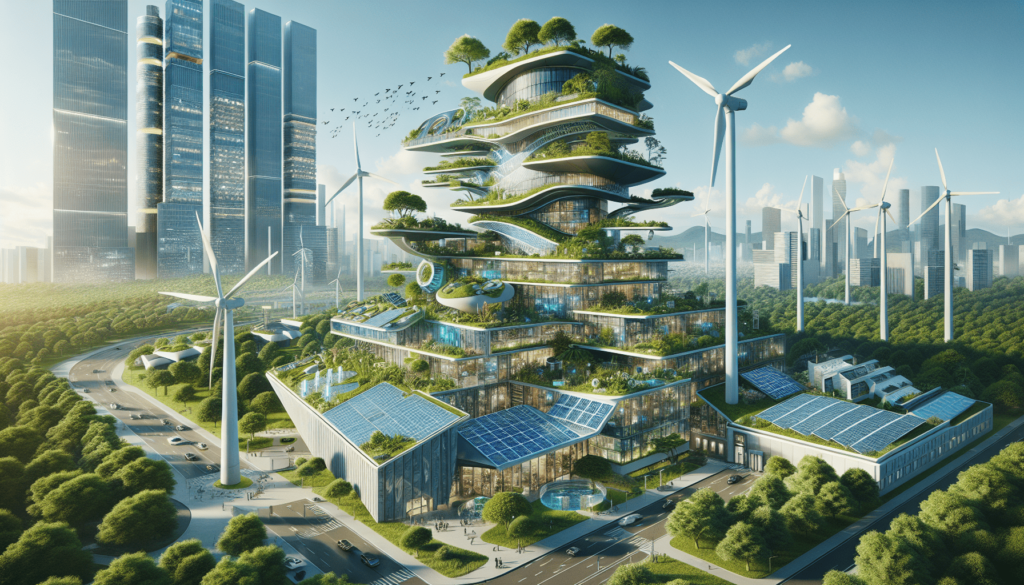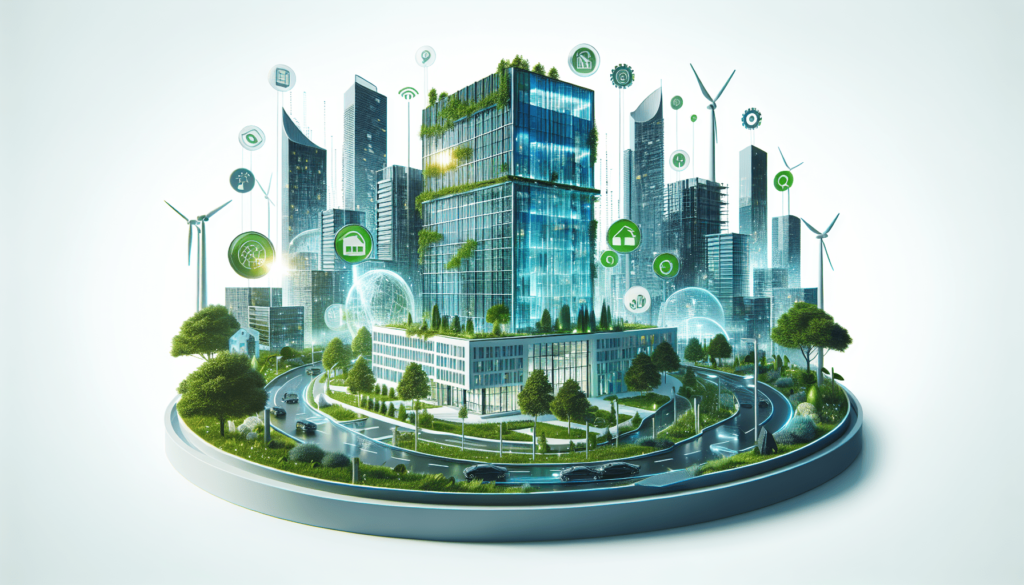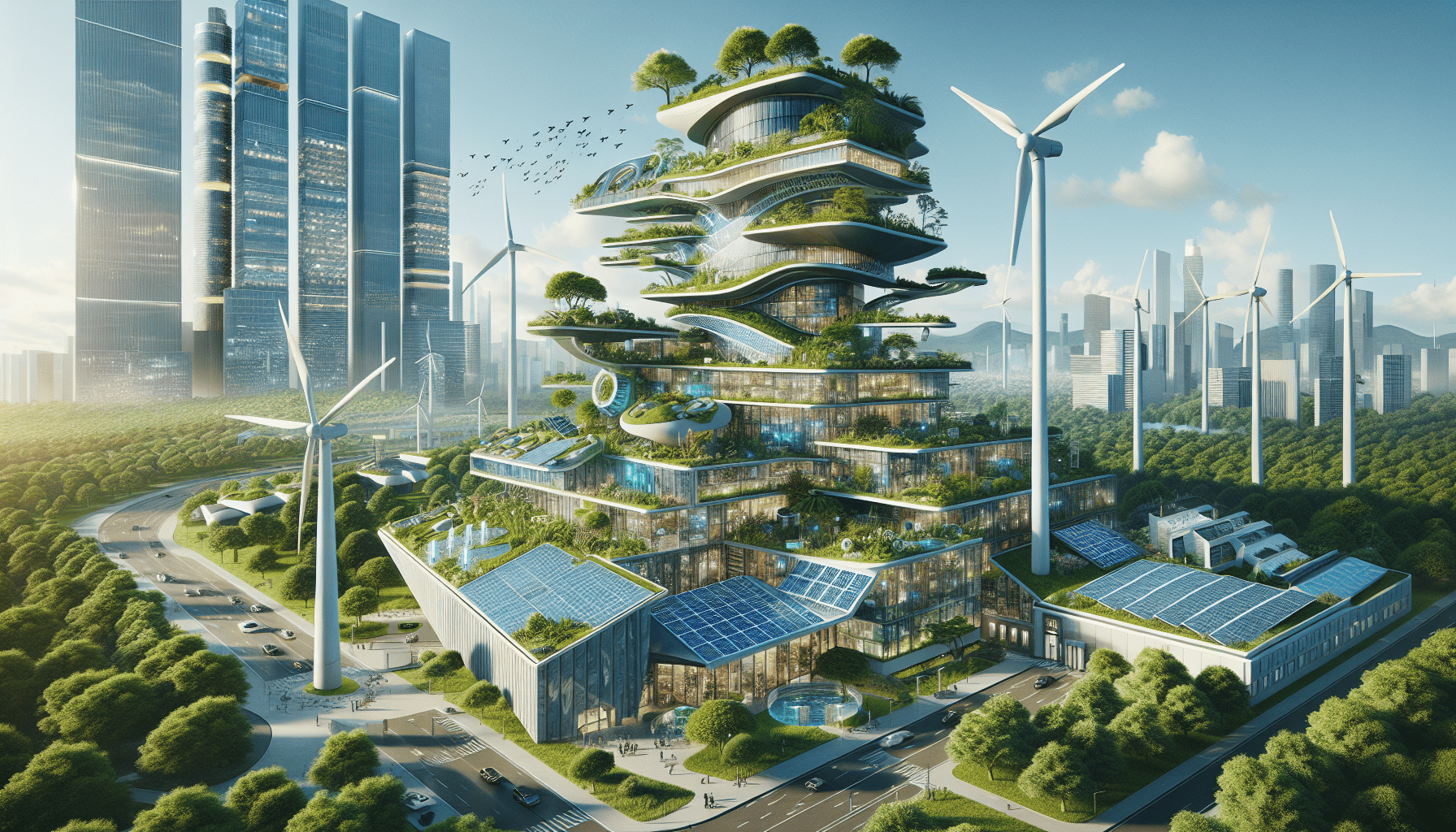Imagine a world where buildings are not just structures, but living organisms that harmonize with the environment, reduce carbon emissions, and prioritize sustainability. This vision of the future is becoming a reality with the emergence of green buildings and architecture. From innovative energy-efficient designs to sustainable materials, this article explores the exciting advancements and potential of green buildings, giving you a glimpse into a future where sustainability and aesthetics seamlessly intertwine. Get ready to witness the transformative power of green architecture and join the movement towards a greener and more sustainable future.
Sustainable Materials
Introduction of eco-friendly materials
In recent years, there has been a growing recognition of the importance of using sustainable materials in construction. Traditional building materials, such as concrete and steel, contribute significantly to carbon emissions and other detrimental environmental impacts. However, the development and implementation of eco-friendly materials offer a promising solution to minimize the ecological footprint of buildings. These materials include recycled and reclaimed materials, as well as innovative alternatives sourced from renewable resources.
Advancements in recycling technology
Recycling technology has made significant advancements, enabling the reuse of materials that were previously considered waste. This includes the recycling of construction and demolition waste, plastic, glass, and metal. Innovative techniques have emerged, such as the use of crushed recycled concrete as a substitute for traditional aggregates in construction. The integration of recycling technology in the building industry not only reduces the overall environmental impact but also helps to address the issue of waste management.
Innovative use of organic materials
Another exciting development in sustainable construction is the utilization of organic materials. These materials are derived from natural sources, such as timber, bamboo, and straw. Organic materials offer several benefits, including their renewable nature and low carbon footprint. Timber, for example, can be sustainably harvested from responsibly managed forests. These materials not only provide a healthier living environment but also contribute to the reduction of greenhouse gas emissions by sequestering carbon dioxide.
Renewable Energy Integration
Solar energy systems
One of the most common and widely adopted renewable energy sources in buildings is solar energy. Solar panels, also known as photovoltaic (PV) systems, harness the power of the sun and convert it into electricity. They can be installed on rooftops, facades, or even as stand-alone structures. Solar energy systems not only provide a clean and renewable source of electricity but can also significantly reduce the reliance on fossil fuels and lower energy costs.
Wind turbines and green roofs
In addition to solar energy, wind turbines can be integrated into buildings to generate renewable electricity. These compact turbines harness wind energy and can be installed on rooftops or other suitable locations. Furthermore, the concept of green roofs has gained traction in recent years. Green roofs are covered with vegetation, which not only provides insulation but can also generate energy through the use of specialized plant materials that convert sunlight into electricity.
Geothermal energy utilization
Geothermal energy is another renewable energy option that can be integrated into buildings. This technology harnesses the heat stored beneath the Earth’s surface and converts it into usable energy. Geothermal systems use heat pumps to transfer the heat from the ground to provide heating or cooling for buildings. By utilizing the constant temperature of the Earth, geothermal energy offers a sustainable and efficient solution for heating and cooling.

Smart Building Technologies
Internet of Things (IoT) in buildings
The Internet of Things (IoT) has revolutionized various industries, and the building sector is no exception. IoT refers to the network of interconnected devices that can collect and exchange data. In buildings, IoT technology can be utilized to optimize energy consumption, monitor and control building systems, and enhance occupant comfort. By integrating IoT devices, buildings can become more intelligent, adaptive, and energy-efficient.
Automated systems for energy management
Automated systems play a crucial role in optimizing energy management in buildings. These systems can automatically adjust lighting levels, HVAC settings, and other energy-consuming processes based on occupancy, time of day, or specific conditions. For example, smart thermostats can learn the occupants’ preferences and adjust the temperature accordingly, reducing energy waste. By automating energy-intensive processes, buildings can achieve significant energy savings and improve overall efficiency.
Enhanced monitoring and control systems
Monitoring and control systems are essential for managing energy consumption and improving operational efficiency in buildings. Advanced sensors and meters can provide real-time data on energy use, occupancy levels, and environmental conditions. This information can be utilized to identify energy-saving opportunities, optimize equipment performance, and detect faults or inefficiencies. Enhanced monitoring and control systems allow building operators to make informed decisions and ensure optimal energy management.
Biophilic Design
Integration of nature and green spaces
Biophilic design emphasizes the integration of nature and green spaces within the built environment. The incorporation of natural elements, such as plants, water features, and natural light, can create a connection with the natural world and enhance overall well-being. Green spaces, both indoors and outdoors, provide numerous benefits, including improved air quality, reduced stress levels, and increased productivity. By bringing nature into buildings, biophilic design promotes a healthier and more sustainable living environment.
Health benefits of biophilic design
In addition to the aesthetic benefits, biophilic design has been proven to have significant health benefits. Research has shown that exposure to nature and greenery has a positive impact on mental health and well-being. It can reduce stress, improve cognitive function, and enhance mood and creativity. Incorporating biophilic design elements, such as living walls or indoor gardens, can create a soothing and rejuvenating environment for occupants.
Improving indoor air quality
Indoor air quality is a critical factor in maintaining a healthy living and working environment. Poor indoor air quality can lead to various health issues, including respiratory problems, allergies, and fatigue. Biophilic design promotes the use of plants, which not only enhance the aesthetics but also act as natural air purifiers. Plants absorb carbon dioxide and release oxygen, while also filtering out harmful toxins and pollutants from the air. By integrating plants into indoor spaces, biophilic design improves indoor air quality and creates a healthier atmosphere.

Energy-Efficient Strategies
Passive design techniques
Passive design techniques focus on utilizing natural elements and processes to minimize energy consumption. This includes optimizing building orientation to maximize natural light and passive solar heating, as well as incorporating shading devices to reduce heat gain during the summer months. Proper insulation and airtight construction also play a crucial role in reducing energy loss. By leveraging passive design strategies, buildings can significantly reduce their reliance on artificial heating, cooling, and lighting systems.
Improved insulation and glazing
Building envelope components, such as insulation and glazing, play a critical role in optimizing energy efficiency. High-quality insulation materials minimize heat transfer and maintain thermal comfort inside buildings. Similarly, advanced glazing technologies, such as low-emissivity coatings and double-glazing, reduce heat gain or loss through windows while still allowing natural light to enter. By incorporating improved insulation and glazing, buildings can minimize energy loss and create comfortable indoor environments.
Efficient lighting and HVAC systems
Lighting and HVAC systems are among the most energy-intensive components in buildings. Implementing energy-efficient lighting solutions, such as LED lights and sensors, can significantly reduce electricity consumption. Similarly, utilizing advanced HVAC technologies, such as high-efficiency systems and smart controls, can optimize energy usage for heating and cooling. By adopting efficient lighting and HVAC systems, buildings can achieve substantial energy savings and reduce their carbon footprint.
Vertical Gardens and Green Facades
Benefits of green walls and vertical gardens
Vertical gardens, also known as green walls, are vertical structures covered with plants. Green facades, on the other hand, are climbing plants that cover the facades of buildings. These features offer several benefits, including improved air quality, reduced noise pollution, and enhanced aesthetics. They can also act as natural insulation, reducing the heat gain or loss through the building envelope. Vertical gardens and green facades not only contribute to a healthier environment but also beautify urban spaces.
Enhancing urban biodiversity
Urban environments often lack biodiversity due to the dominance of concrete and asphalt. However, vertical gardens and green facades provide opportunities to reintroduce vegetation and enhance urban biodiversity. By creating habitats for birds, insects, and other wildlife, these green features can contribute to the ecological balance and promote a more sustainable urban ecosystem. Additionally, increased biodiversity can provide educational and recreational benefits for residents and visitors.
Reducing urban heat island effect
The urban heat island effect refers to the phenomenon of increased temperatures in urban areas compared to surrounding rural areas. This is primarily due to the excessive heat-absorbing surfaces, lack of vegetation, and high energy consumption in cities. However, vertical gardens and green facades help mitigate this effect by reducing the surface temperature through evaporative cooling and shading. The presence of vegetation can also create a microclimate that is cooler and more comfortable for pedestrians and residents.
Water Conservation and Management
Rainwater harvesting systems
Water scarcity is a global concern, and buildings have a significant impact on water consumption. Rainwater harvesting systems offer a sustainable solution by collecting and storing rainwater for various non-potable uses, such as irrigation, toilet flushing, and laundry. By reducing the reliance on freshwater sources, rainwater harvesting systems conserve water resources and minimize the strain on municipal water supply networks. Additionally, these systems can help reduce stormwater runoff and prevent flooding.
Greywater recycling systems
Greywater refers to wastewater from non-toilet fixtures, such as sinks, showers, and washing machines. Greywater recycling systems treat and reuse this water for irrigation or toilet flushing. By separating greywater from blackwater (toilet wastewater), buildings can reduce the overall water demand and minimize the strain on sewage systems. Greywater recycling systems not only conserve water but also contribute to the sustainable management of water resources.
Efficient plumbing fixtures
The choice of plumbing fixtures can have a significant impact on water consumption in buildings. Low-flow faucets, showerheads, and toilets utilize less water while maintaining optimal functionality. Additionally, sensor-based controls and automatic shut-off features can prevent water wastage. By adopting efficient plumbing fixtures, buildings can achieve substantial water savings without compromising user experience. This contributes to overall water conservation efforts and promotes sustainable water management.
Urban Farming and Rooftop Gardens
Utilizing rooftops for agriculture
Rooftop gardens and urban farming have gained popularity as a means of utilizing underutilized spaces for food production. By transforming rooftops into agricultural spaces, buildings can contribute to local food production and promote food self-sufficiency. Urban farms can cultivate a variety of crops, including fruits, vegetables, and herbs, depending on the available space and climate. Rooftop agriculture not only provides fresh and locally sourced produce but also reduces the carbon footprint associated with transportation and storage of food.
Promoting food self-sufficiency
Food security is a pressing issue in urban areas, as the distance between food production and consumption is often significant. Rooftop gardens and urban farming initiatives promote food self-sufficiency by bringing food production closer to the point of consumption. This reduces dependence on external food sources and lowers the environmental impact associated with long-distance transportation. Additionally, urban farming can strengthen community bonds and provide educational opportunities for residents, fostering a sense of ownership and connection to food production.
Improving urban food security
Urban areas often face challenges in ensuring a stable and reliable food supply. By integrating urban farming and rooftop gardens, cities can enhance food security by diversifying food sources and reducing vulnerability to disruptions in the global food system. Localized food production also increases resilience to climate change and other external factors that may impact food availability. Furthermore, urban agriculture creates employment opportunities and stimulates economic growth within communities, contributing to overall sustainable development.
Adaptive Reuse of Existing Structures
Benefits of repurposing buildings
Repurposing existing structures offers numerous benefits compared to new construction. Adaptive reuse not only preserves the historical and architectural significance of buildings but also reduces the demand for new materials and energy-intensive construction processes. Repurposing buildings can save significant amounts of embodied energy and resources, while also reducing construction waste. Additionally, adaptive reuse can revitalize underutilized urban areas, fostering economic growth and promoting sustainable urban development.
Preservation of historical architecture
Many existing buildings possess significant historical or architectural value and contribute to the cultural heritage of a community. By repurposing these buildings, their unique character and craftsmanship can be preserved, helping to maintain the cultural identity and sense of place. Preservation of historical architecture through adaptive reuse allows future generations to appreciate and learn from the past while still meeting the evolving needs of the community. This approach supports sustainable development by balancing the preservation of heritage with the demand for modern functionality.
Reducing construction waste
Construction waste is a major environmental concern, as it occupies landfill space and contributes to greenhouse gas emissions. By repurposing existing buildings, the need for new construction and associated waste generation can be minimized. Adaptive reuse allows for the incorporation of existing materials, structures, and infrastructure, reducing the overall ecological footprint. Additionally, repurposing buildings can inspire creativity and innovative design approaches, resulting in unique and visually appealing spaces.
Resilient and Disaster-Resistant Design
Designing for climate change impacts
Climate change poses significant challenges to the built environment, including increased frequency and intensity of extreme weather events. Resilient and disaster-resistant design aims to mitigate the impacts of climate change by incorporating measures to withstand and adapt to these challenges. This includes designing buildings that can withstand high winds, flooding, and temperature fluctuations. By integrating climate-responsive strategies, buildings can become more resilient, ensuring the safety and well-being of occupants during extreme weather events.
Sustainable solutions for natural disasters
Natural disasters, such as earthquakes, hurricanes, and wildfires, can cause significant damage to buildings and infrastructure. Sustainable design solutions can help minimize the impact of these disasters and facilitate the recovery process. This includes the use of resilient materials, such as reinforced concrete or steel, as well as advanced structural engineering techniques. Sustainable solutions for natural disasters prioritize the safety of occupants and the long-term functionality of buildings while minimizing the environmental and social impacts.
Integration of resilient infrastructure
Resilient infrastructure plays a vital role in adapting to the challenges posed by climate change and natural disasters. This includes incorporating features such as backup power systems, water storage, and drainage mechanisms to ensure the continuous functioning of essential building systems during emergencies. Furthermore, the integration of renewable energy systems into resilient infrastructure can provide a reliable and sustainable source of power during disruptions. By combining resilient design principles with sustainable infrastructure, buildings can enhance their ability to withstand and recover from diverse threats.
As the world continues to prioritize sustainability and environmental consciousness, green buildings and architecture will play an increasingly important role. The comprehensive integration of sustainable materials, renewable energy, smart technologies, biophilic design, energy-efficient strategies, vertical gardens, water conservation, urban farming, adaptive reuse, and resilient design will shape the future of green buildings. By embracing these innovative practices, we can create a built environment that promotes health, conserves resources, and mitigates the impacts of climate change. The future of green buildings and architecture is both promising and essential for a sustainable and resilient future.

